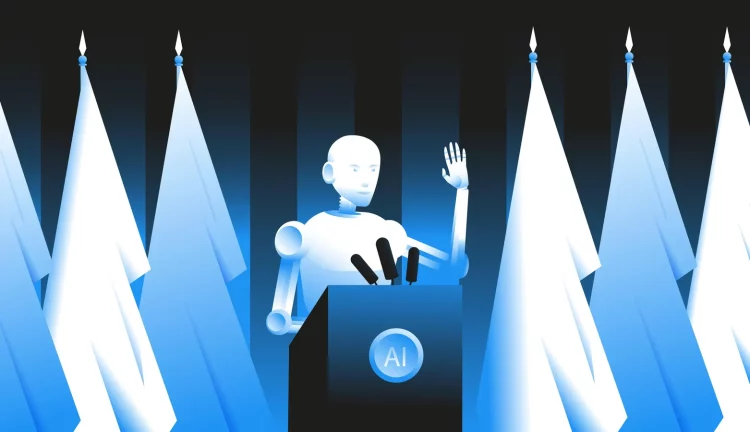Introduction: The Dawn of the AI Era
In recent years, artificial intelligence (AI) has evolved from a niche technology to a driving force reshaping industries worldwide. What was once the realm of sci-fi has now become a mainstream tool, with AI impacting nearly every sector, from manufacturing and healthcare to finance and retail. This technological revolution is not just about innovation; it’s about redefining business models, creating new efficiencies, and reimagining the future of work.
The core question for business leaders today is: how can they leverage AI to not only stay competitive but also lead their industries through this seismic shift? In this article, we will explore how AI is revolutionizing traditional industries and the strategies business leaders must adopt to navigate and thrive in this new landscape.
Chapter 1: Understanding the Power of AI and Its Disruptive Potential
1.1 What Exactly Is Artificial Intelligence?
At its core, artificial intelligence refers to the ability of machines and systems to perform tasks that typically require human intelligence, such as problem-solving, pattern recognition, speech processing, and decision-making. AI can be classified into various subfields, including:
- Machine Learning (ML): This is the technology that allows systems to learn from data and improve their performance over time without being explicitly programmed.
- Natural Language Processing (NLP): The ability of machines to understand, interpret, and respond to human language.
- Computer Vision: Enabling machines to interpret and make decisions based on visual data (images and video).
- Robotics and Automation: Using AI to control robots and autonomous systems, enabling them to carry out complex tasks in real-world environments.
1.2 AI’s Disruptive Impact Across Industries
AI is fundamentally changing the way companies operate, offering unprecedented opportunities for efficiency, automation, and innovation. Here’s how it is impacting several key industries:
- Manufacturing: AI-powered automation is transforming production lines, optimizing supply chains, and increasing efficiency. Predictive maintenance, using AI to anticipate equipment failures before they happen, has become a game-changer for manufacturers.
- Healthcare: AI is revolutionizing diagnostics, drug discovery, and personalized medicine. AI algorithms can analyze medical data faster and more accurately than humans, leading to quicker diagnoses and more tailored treatments.
- Finance: In finance, AI is used for fraud detection, algorithmic trading, and personalized financial advice. AI tools analyze large datasets to identify trends, predict market movements, and make investment decisions.
- Retail: AI enhances customer experience by offering personalized shopping recommendations and automating inventory management. Retail giants like Amazon and Alibaba use AI for everything from customer support via chatbots to supply chain optimization.
- Transportation and Logistics: The rise of autonomous vehicles, drones, and smart logistics systems is revolutionizing transportation and supply chain management, with AI improving delivery times and reducing costs.
Chapter 2: How AI is Transforming Traditional Business Models
2.1 Automation and Efficiency Gains
One of the most immediate impacts of AI on traditional industries is the automation of routine and repetitive tasks. This leads to significant cost reductions and the ability to scale operations without increasing human labor. Key areas of automation include:
- Customer Support: AI-powered chatbots and virtual assistants can handle customer queries 24/7, reducing the need for large call centers and improving response times.
- Manufacturing: AI-enabled robots can perform assembly line tasks, reducing human error and improving speed. This has led to the rise of smart factories where machines work in sync to optimize production processes.
- Data Analysis: AI can process vast amounts of data far more quickly than humans, uncovering insights that were previously difficult to identify. This allows businesses to make data-driven decisions in real time, from marketing strategies to operational improvements.
2.2 Personalization and Customer Experience
AI is enabling businesses to create hyper-personalized experiences for customers, a critical component in today’s highly competitive market. Companies can use AI to:
- Analyze Customer Behavior: By analyzing customer preferences, buying patterns, and interactions, AI can help companies develop targeted marketing campaigns and personalized product recommendations. Netflix and Spotify, for instance, use AI to curate content based on individual user tastes.
- Predictive Analytics: AI allows businesses to predict future customer behavior and demands. This enables companies to optimize inventory management, personalize offers, and anticipate customer needs before they arise.
- Enhanced User Interfaces: AI is used to enhance user experiences across digital platforms, from voice-activated assistants like Amazon’s Alexa to intelligent search algorithms on e-commerce websites.
2.3 Improved Decision Making and Forecasting
AI is transforming decision-making in several ways:
- Data-Driven Decisions: AI can process and analyze vast amounts of structured and unstructured data, turning it into actionable insights for business leaders. From supply chain optimization to demand forecasting, AI helps businesses make informed decisions.
- Financial Forecasting: AI tools are being used to predict market trends, assess investment opportunities, and manage risk. Companies are leveraging AI for algorithmic trading, creating automated systems that buy and sell stocks based on real-time market data.
- Real-Time Adjustments: AI allows businesses to make real-time adjustments to operations based on ongoing data. For example, retailers can modify product prices based on customer demand, competitor pricing, and inventory levels.

Chapter 3: How Business Leaders Should Respond to the AI Revolution
3.1 Develop a Strategic AI Vision
Business leaders need to approach AI not as a trend, but as a strategic investment that will fundamentally change their industries. Developing an AI strategy requires a deep understanding of how AI can enhance operations, improve products, and redefine customer experiences. Leaders should:
- Identify Key Use Cases: Prioritize areas where AI can have the most impact, such as automating routine tasks, enhancing customer service, or improving supply chain management.
- Invest in Talent and Resources: Building AI expertise within the organization is crucial. This may involve hiring data scientists, partnering with AI technology firms, or investing in AI training for existing staff.
- Align AI with Business Goals: Ensure that AI investments align with broader business objectives, whether that’s increasing profitability, enhancing customer experience, or boosting innovation.
3.2 Foster a Culture of Innovation
AI adoption requires a shift in organizational culture. Business leaders must foster a mindset that embraces technology-driven innovation. This involves:
- Encouraging Experimentation: AI is still evolving, so organizations should be willing to experiment with new technologies, pilot projects, and iterate on their AI initiatives.
- Collaboration Across Teams: AI initiatives should involve collaboration between IT, operations, marketing, and other departments to ensure that AI projects are aligned with the company’s overall strategy.
- Ethics and Responsibility: As AI systems become more integrated into business processes, leaders must ensure that AI technologies are used ethically. This includes bias mitigation, transparency in decision-making, and maintaining customer trust.
3.3 Invest in AI Partnerships and Ecosystems
In the rapidly evolving AI landscape, companies may not always have the expertise or resources to develop AI solutions in-house. Therefore, strategic partnerships with AI providers, tech startups, and universities can help organizations accelerate their AI initiatives. These partnerships can include:
- Collaborating with AI Startups: Partnering with innovative startups can provide access to cutting-edge technologies and allow businesses to stay ahead of the curve.
- Cloud and AI Platforms: Cloud giants like Amazon Web Services (AWS), Microsoft Azure, and Google Cloud offer AI tools and services that businesses can integrate into their operations without the need for large upfront investments.
3.4 Rethink the Workforce and Upskilling
AI will undoubtedly change the nature of work. Business leaders must ensure that their employees are equipped with the skills needed to thrive in an AI-powered environment. This requires:
- Upskilling and Reskilling: Offering employees the opportunity to learn new skills in data science, machine learning, and AI ethics will help them stay relevant in an increasingly automated world.
- Adapting Roles: While AI will automate many routine tasks, it will also create new job opportunities. Leaders should prepare for the future of work by identifying roles that will be augmented by AI and ensuring a smooth transition for employees.
Chapter 4: The Future of AI and Its Ongoing Impact on Business
4.1 The Ongoing Evolution of AI Technologies
The AI revolution is far from over. As AI continues to advance, we can expect further disruptions and innovations across industries. Here are some future trends to watch:
- AI-Driven Creativity: AI will increasingly be used in creative industries for tasks like generating art, writing, and music. Companies like OpenAI are already exploring AI tools that can generate content.
- AI in Sustainability: AI can be used to optimize energy usage, reduce waste, and drive more sustainable business practices. For example, AI can help businesses monitor and reduce their carbon footprint.
- Ethical AI and Regulations: As AI becomes more pervasive, ethical concerns will continue to grow. Governments and companies will need to address issues like data privacy, algorithmic bias, and responsibility in AI decision-making.
4.2 Conclusion: The Time to Act is Now
The AI revolution is no longer a distant future—it is here, and it is transforming traditional industries in profound ways. Business leaders who embrace AI and develop strategic plans to incorporate these technologies will be best positioned to thrive in this new era. By focusing on automation, personalization, and data-driven decision-making, companies can create a competitive advantage that drives growth and innovation.
However, this transformation is not without its challenges. AI implementation requires careful consideration of ethical issues, workforce adaptation, and ongoing technological advancements. Business leaders must navigate these complexities with foresight and agility to ensure long-term success in an increasingly AI-driven world.
The question is no longer whether AI will disrupt industries, but how leaders will respond to harness its full potential and drive meaningful change. The time to act is now—those who fail to adapt may risk being left behind in this new technological landscape.


















































